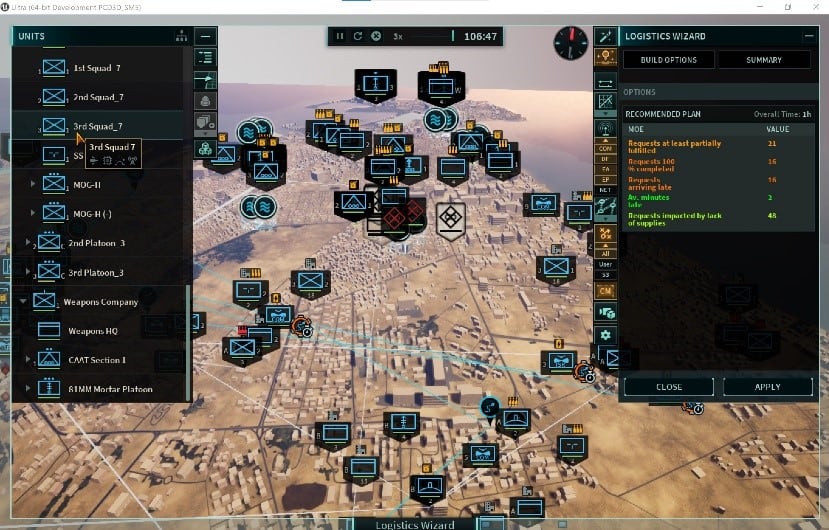The Marine Corps Warfighting Lab now has a software tool for force design and experimentation developed by the same agency that conceived the stealth bomber and an early version of the internet.
The Defense Advanced Research Projects Agency announced recently that it was transitioning its Prototype Resilient Operations Testbed for Expeditionary Urban Scenarios, or PROTEUS, to the Marine Corps Warfighting Lab in Quantico, Virginia.
That was after DARPA launched the program in 2017 and completed a five-day capstone testing and demonstration with Marines from 1st Battalion, 2nd Marine Regiment, at Camp Lejeune, North Carolina, according to a DARPA statement.
“Using the PROTEUS software, Marines were able to visualize and manipulate their electromagnetic footprint, apply logistics support automation, and obtain quantitative analytics on the effectiveness of force packages and tactics in real time,” John Paschkewitz, PROTEUS program manager in DARPA’s Strategic Technology Office, said in the statement.
While still at DARPA, the PROTEUS program was used by Marine Corps leadership to hone some of its Marine Corps’ Force Design 2030 insights. The force design experiments and simulations have and continue to inform major decisions in the structure and functions of the Marine Corps.
In 2020 that meant shedding tanks and tankers from the ranks as well as beginning a large-scale shift away from conventional tube-launched artillery to more rocket artillery systems such as the High Mobility Artillery Rocket System.
In May, Marine Corps Times covered the groundbreaking for a state-of-the-art Wargaming Center at Quantico, Virginia, expected to open by mid-2023.
At that event, Lt. Gen. Eric Smith said that what the center will do is used advanced software and experts in wargaming and Marine programs to decide the best composition of units and the equipment they’ll use in future combat.
“It’s like we’re bracketing,” Smith told Marine Corps Times. “We’re not saying, ‘How far is the target?’ We’re saying that the target is somewhere between 4,000 and 4,500 yards … that’s what this center does.”
Bracketing is a technique often used with indirect fires such as mortars or cannon artillery when determining the distance of a target. A shooter will fire the projectile both short of and past the target, then know the distance where the target lies ― between the two shots.
In some unseen but vital ways, Marines also were able to run conceptual work for force design through the PROTEUS program that would test those concepts back in 2017 before the center was more than a goal for the Corps.
Paschkewitz said the tool allows developers, planners and leaders to look at how to deploy assets that emit electromagnetic signal and what’s possible at the platoon, company and battalion level.
The PROTEUS program has three components:
1 – A virtual test environment that serves as a kind of tactical multidomain “sandbox” for experiments and analysis across echelons. This synthetic environment is called ULTRA.
“Building a commander’s insight and judgment is driven by the fact that there’s a live opponent,” Paschkewitz said. “We built ULTRA around that concept from day one. This is not AI versus AI, or human versus AI, rather there is always a Marine against an ADFOR (adversary force), that’s another Marine, typically, forcing the commander to adapt tactics, techniques, and procedures (TTPs) and innovate at mission speed.”
That allows commanders to immerse themselves in a simulated future conflict. Then they can deploy capabilities they have or future, not-yet-developed capabilities, to see what works best.
“Commanders can hone their battlefield skills, while also training subordinates on employment techniques, delivering a cohesive unit able to execute in a more effective manner,” said Ryan Reeder, model and simulation director, Marine Corps Warfighting Lab Experiment Division.
The system also generates data on leader’s critical decision in key “friction points” in the scenarios, Reeder said.
After those scenarios unfold they can use an NFL-style replay and review decisions, showing the effect of those decisions, he said.
The ULTRA section of PROTEUS displays urban areas in three dimensions, using the below-1,000 foot view from camera mapping equipped drones.

2. The dynamic composition engine known as COMPOSER includes software that can automate equipment loadout and planning to develop commanders plans and what kind of logistical support needed to execute that mission set.
COMPOSER will also use electromagnetic spectrum operations tools to give feedback on EM signature risk, communications assets and network configuration.
“Without the EMSO and logistics wizards, it’s hard to effectively coordinate and execute multi-domain operations,” Paschkewitz said. “Marines can easily coordinate direct and indirect fires but coordinating those with spectrum operations while ensuring logistical support without a staff is challenging. These tools allow Marines to focus on the art of war, and the automation handles the science of war.”
3. The Parametric Data Service loads and updates models maps and other elements that keep the first two components, ULTRA and COMPOSER relevant and ready. It uses specifications for everything from radio range to vehicle capabilities to weapons ranges and effects.
“The portability of the PROTEUS kit has been essential to us getting the capability to where Marines train,” Paschkewitz said. “It’s been great to see a communications or radio battalion Marine sit next to an Infantryman on PROTEUS computers and be able to understand each other, plan, and execute in innovative ways.”
By pulling together these tools, Reeder said, users can conduct virtual integration in early experiments for tactics, techniques and procedures before the first live experimentation begins. That can reduce risk, cost and time.
Todd South has written about crime, courts, government and the military for multiple publications since 2004 and was named a 2014 Pulitzer finalist for a co-written project on witness intimidation. Todd is a Marine veteran of the Iraq War.





